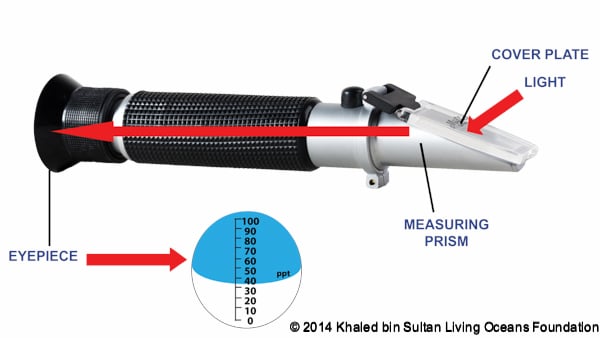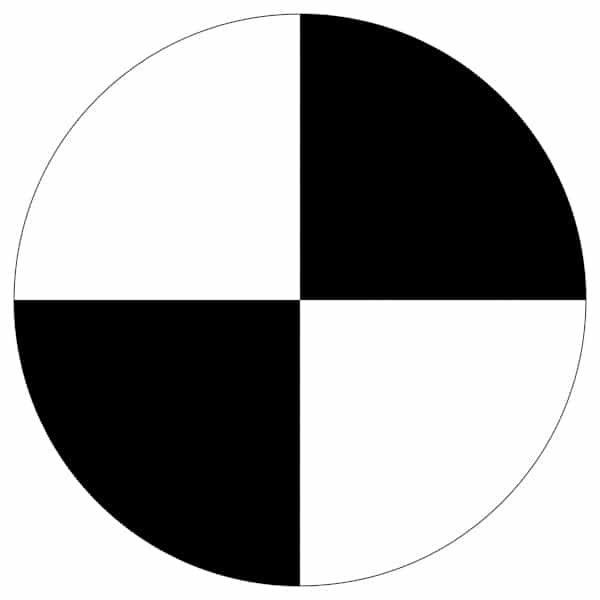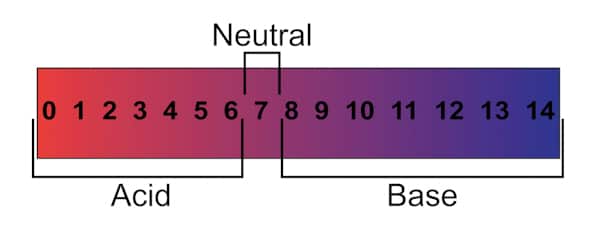Fact Friday
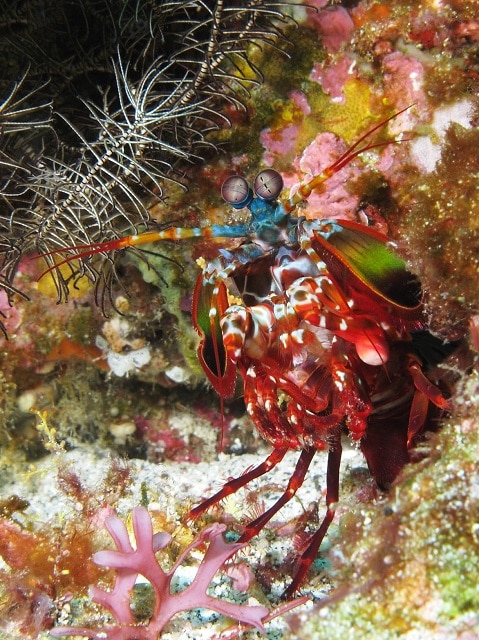
The colorful mantis shrimp is no wimp. They can box far above their weight class due to their secret weapon. They store energy in their arm which allows them to strike with the power of a 22 caliber bullet. Check out this video to see one in action.
Mantis shrimp By Alexander Vasenin [CC-BY-SA-3.0 (https://creativecommons.org/licenses/by-sa/3.0/] 15 September 2010 via Wikimedia Commons. https://commons.wikimedia.org/wiki/File:Curious_mantis_shrimp_from_Gilli_Banta_reef.JPG.
Environmental Conditions
Corals have certain environmental conditions that they need in order to survive. These factors limit where corals can live. In this unit, we will learn about the abiotic factors that corals need to thrive.
These environmental conditions are referred to as biotic and abiotic factors. Remember, we can break down the word abiotic:
a biotic
without life
Therefore, abiotic means without life. Abiotic factors are non-living components of an organism’s environment. Do you remember what biotic means? It means life. Biotic factors are living or once living components of a community.
Coral reefs are complex ecosystems. There are many different biotic factors that affect coral reefs. They will be discussed throughout different units. For now, we will focus on the abiotic factors that affect corals.
Can you think of any abiotic factors that may affect coral reef ecosystems?
Here are some examples:
| Abiotic Factors |
| Water |
| Light |
| Wind |
| Sediment |
| pH |
| Temperature |
| Pressure |
| Salinity |
| Humidity |
| Weather |
| Waves |
| Current |
| Ocean depth |
| Substrate |
| Turbidity |
| Inorganic nutrients (phosphorus, nitrogen, etc.) |
| Dissolved gases – oxygen (O2), nitrogen (N2), carbon dioxide (CO2), etc. |
| Aragonite and calcium carbonate saturation (we will discuss more about this in later units) |
Abiotic Factors
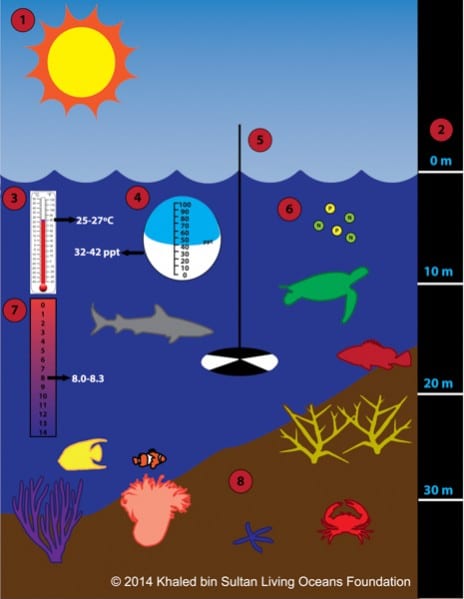
There are multiple abiotic factors that affect coral reefs (figure 8-1). The numbers in the diagram correspond to the numbered descriptions below. Here are the optimal parameters for corals to live in:
- Light: Corals need a moderate amount of sunlight in order to survive. Light is rapidly absorbed by seawater and does not penetrate to great depths. If there is too little light, then the zooxanthellae will not be able to photosynthesize and produce food for corals. Too much light, especially ultraviolet (UV), may cause corals to expel zooxanthellae, causing them to bleach. In later units, we will learn more about coral bleaching.
- Depth: Reef building corals must live where there are moderate amounts of light. Recall that corals have a symbiotic relationship with zooxanthellae living inside their tissues. These algae photosynthesize in order to create food and nutrients for corals. See Unit 4: Coral Feeding for more information. Corals can live in depths less than 230 feet (70 meters), but are typically found at approximately 98 feet (30 meters).
- Water temperature: Remember that corals thrive in the warm waters of the tropics. They prefer a water temperature range of 60.8–93.9°F (16–34.4°C). This range varies for corals depending on the temperature to which they have adapted (Dubinsky & Falkowski 2011).
- Salinity: Salinity is usually measured in parts per thousand (ppt). Corals can tolerate a salinity range of 23–42 ppt. The average ocean salinity is 35 ppt. Let’s think of salinity like this, if we have 1,000 buckets of seawater, 35 of those buckets will be filled with salt and the other 965 will contain freshwater. For more about salinity, see Unit 7: Distribution.
Salinity can be measured by using a hand-held refractometer (figure 8-2). When using this tool, a small drop of seawater is placed between a measuring prism and a cover plate. Light passes through the sample and the light is refracted through the prism to the scale. By looking through the eyepiece, the salinity can be read. There are other tools, such as hydrometers and conductivity meters, that are also used to measure salinity.
Figure 8-2. The light (red arrow) bends through a refractometer giving a salinity reading, which is seen through the eyepiece.
- Turbidity: Turbidity is the measure of the clarity of water. When there are particles in the water, this inhibits light from penetrating through the water column. Turbidity can be caused by phytoplankton, sediments, runoff, pollution, etc.
Corals need clear water (water with low turbidity) so that the light can penetrate through the water column, allowing the zooxanthellae to photosynthesize. When there is high turbidity, light can’t penetrate through the suspended particles. Additionally, corals can be smothered by sediments or particles that settle on top of the corals. Eventually, this could lead to the coral dying.
One way to measure turbidity is to use a Secchi disk. A Secchi disk is often an 8 inch (20.3 centimeter) round disk that has alternating black and white quadrants (figure 8-3).
Secchi disks are lowered into the water with a rope. Light reflects off of the top of the Secchi disk. When the Secchi disk is no longer able to be seen, the person stops lowering the rope. Then they record the depth that is marked on the rope. Using the Secchi depth, scientists can calculate the turbidity of the water.
Figure 8-3. Secchi disk pattern.
- Nutrients: Corals prefer low nutrient water. Nutrients include phosphorus (P) and nitrogen (N). When there are lots of nutrients, this may cause algae and phytoplankton to grow. This process can block out the light that zooxanthellae need to survive. Also, algae can overgrow coral while competing for space. If the coral cannot get light, then it will die.
- pH: Whether a solution is an acid or a base is the measurement of its pH. The pH scale ranges from zero to fourteen (figure 8-4). Seven is neutral, which is the pH of pure water. A pH of less than seven is acidic (like vinegar) and a pH greater than seven is basic (like bleach).
Figure 8-4. pH scale
Corals prefer seawater to have a pH level between 8.0–8.3, which is the standard pH of saltwater. It is very difficult for corals to grow in acidic conditions. We will learn more about this topic and how it is related to ocean acidification in later units.
- Substrate: A surface where an organism can attach and/or grow is called a substrate. Corals need to attach to a hard surface. Recall that most corals are sessile meaning that they do not move once mature.
Fun fact
Fun Fact

On a coral reef, space can be very limited and corals must compete with sponges, macroalgae (seaweed), and even other coral species. When space becomes limited, most corals can’t pick up and move. Instead, they battle it out with their neighbors. Some coral polyps do this by extending their mesenteries from their stomachs. Then the battle begins. The mesentery strands cover the intruder species and the coral releases digestive enzymes that begin to devour their neighbor. This battle for territory can be seen in the Coral Nighttime Battle. Click on video #5 to view.
Remember that these are general parameters and that there are corals that have adapted to different conditions. For example, Siderastrea radians, the lesser starlet coral, has adapted to living in very stressful conditions in Florida Bay (Lirman et al. 2002). This large body of water is an estuarine area where seawater mixes with freshwater. The average depth in Florida Bay is 5 feet (152.4 centimeters), which is one of the reasons that environmental conditions fluctuate greatly. During the dry season, when there is little to no rain and evaporation rates are high, salinity levels can reach hypersaline conditions (greater than 40 ppt). It has also been documented that certain basins in Florida Bay reach over 70 ppt. This would be a very difficult place to live if you were a coral. Remember that most corals can tolerate 23–42 ppt.
In another example, American Samoa corals have adapted to high temperatures that can easily exceed 89.6°F (32°C) for multiples hours and days at a time (Craig et al. 2001). This gives us hope that some corals will adapt to climate change and warming seas.
There are other abiotic factors that affect coral reefs. We have already learned how currents can affect distribution of coral reefs in Unit 7: Distribution. There are other abiotic factors that we will learn more about in later units (see Unit 9: Coral Growth). We will also learn about the biotic factors that affect coral reefs too (see Unit 16: Food Webs, coming soon).
ATTRIBUTIONS & CITATIONS
ATTRIBUTIONS
Figure 8-1. Sun. 2014 via Clipart Panda. http://www.clipartpanda.com/clipart_images/sun-clipart-medium-5602503.
Figure 8-1. Thermometer. n.d. via Teacher’s Files. http://www.teacherfiles.com/clip_art_thermometers.htm.
Figure 8-2. Refractometer adapted from CEphoto, Uwe Aranas [CC-BY-SA-3.0 (http://creativecommons.org/licenses/by-sa/3.0) or GFDL (http://www.gnu.org/copyleft/fdl.html)], 29 Oct 2013 via Wikimedia Commons. https://commons.wikimedia.org/wiki/File%3APortable-Refractometer-03.jpg.
Figure 8-3. By User: Mysid (Own work) [Public domain], 1 Nov 2005 via Wikimedia Commons. http://upload.wikimedia.org/wikipedia/commons/0/0b/Secchi_disk_pattern.svg.
CITATIONS
Craig, P., Birkeland, C., & Belliveau, S. (2001). High temperatures tolerated by a diverse assemblage of shallow-water corals in American Samoa. Coral Reefs 20: 185-189.
Dubinsky, Z. & Falkowski, P. (2011). Light as a source of information and energy in zooxanthellate corals. In: Dubinsky, Z. and Stambler, N. (eds.) Coral reefs: an ecosystem in transition, Springer, Dordrecht.
Lirman, D., Orlando, B., Marcia, S., Manzello, D., Kaufman, L., Biber, P., Jones, & Tahzay, J. (2002). Coral communities of Biscayne Bay, Florida and adjacent offshore areas: diversity, abundance, distribution, and environmental correlates. Aquatic Conservation: Marine and Freshwater Ecosystems 13(2): 121-135.





